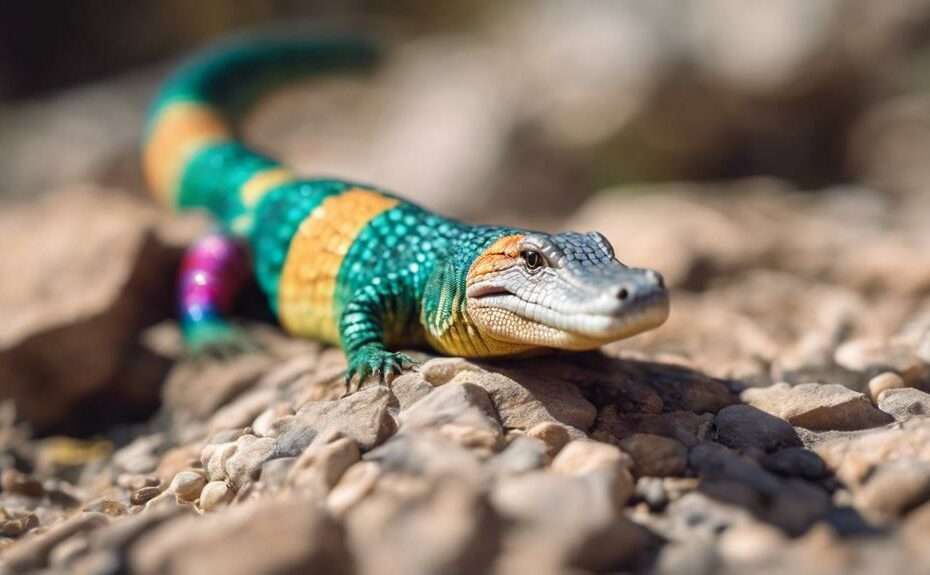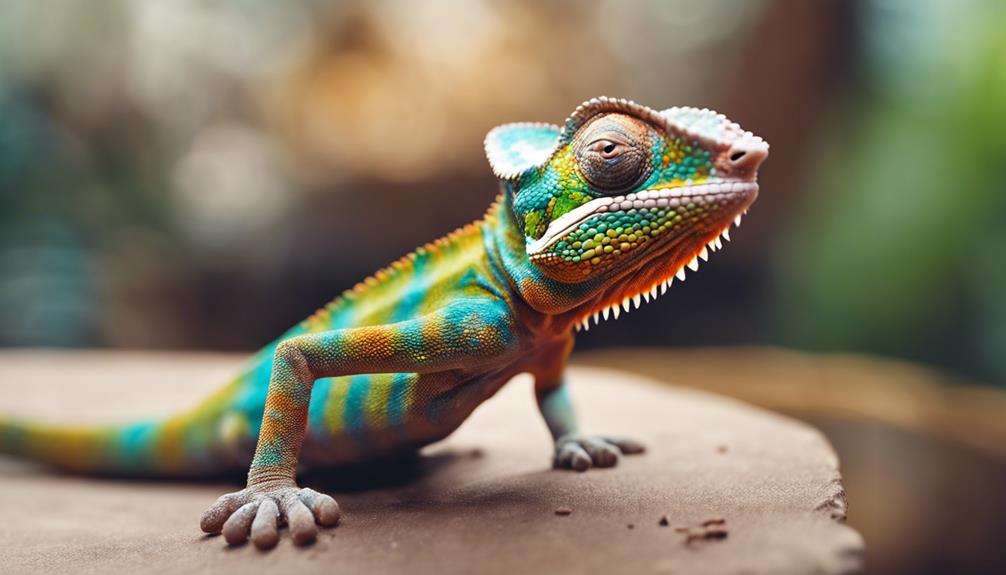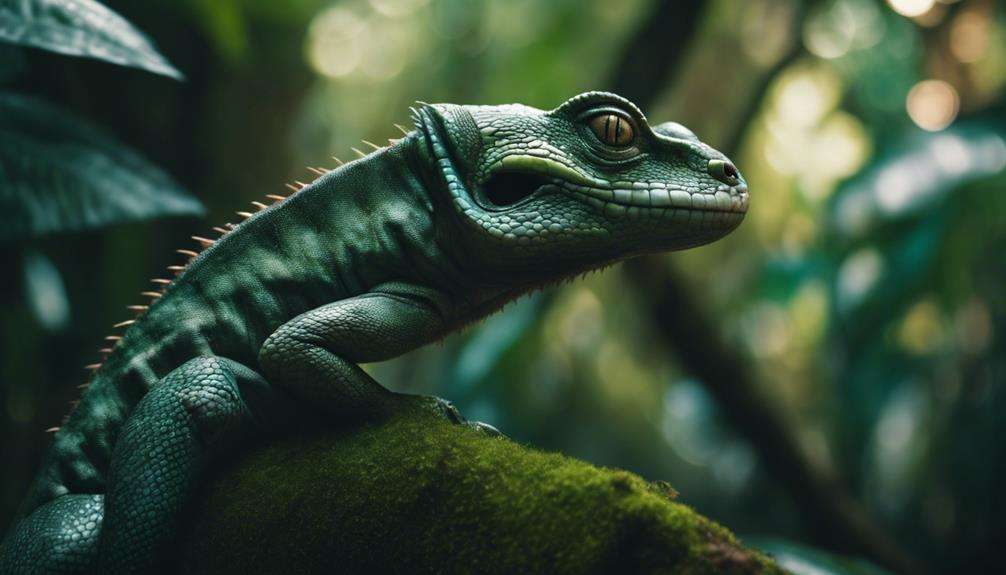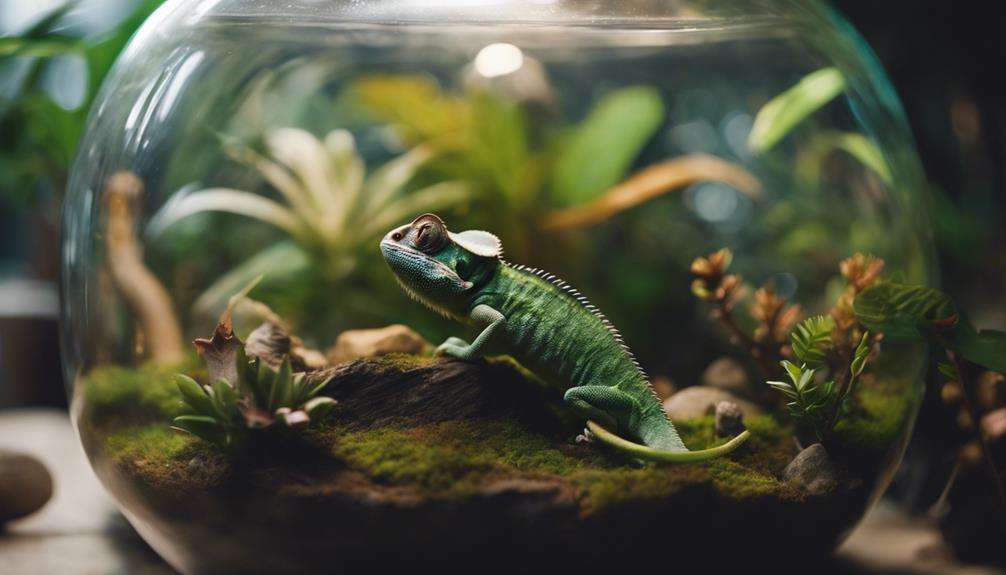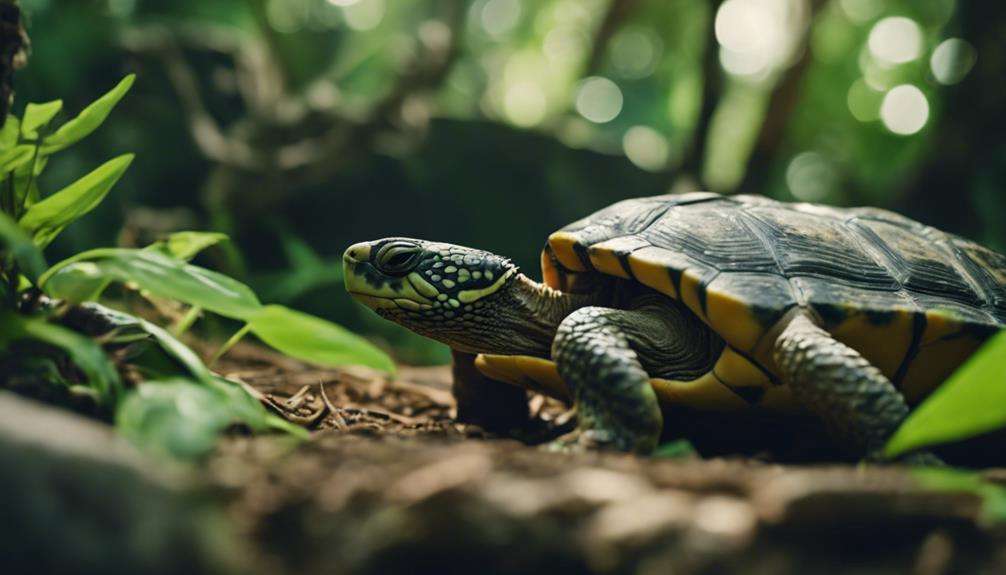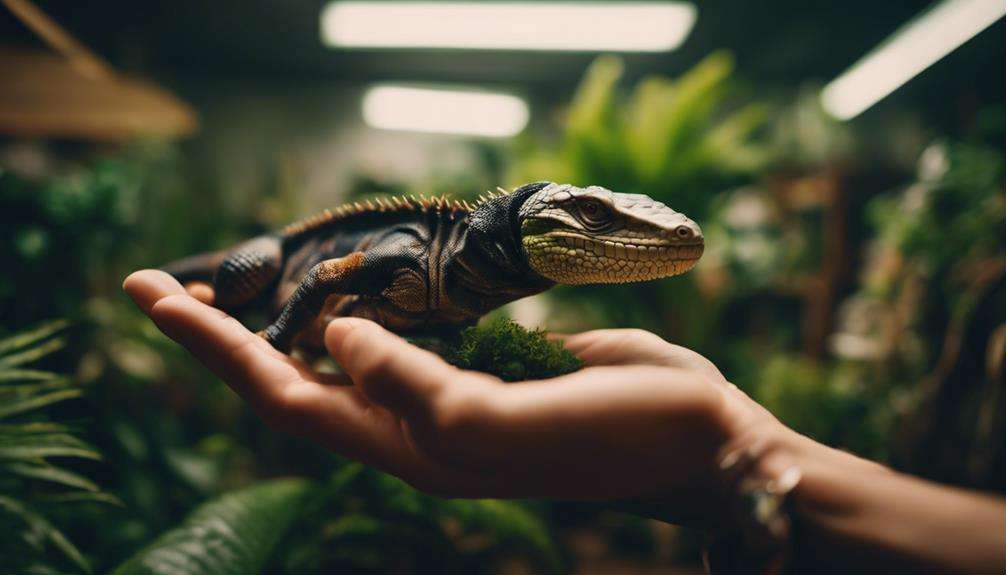You wouldn't expect a reptile with a name like the Satanic Leaf-Tailed Gecko to be a charming addition to your pet collection. However, these uncommon reptiles hold secrets that might surprise you.
Their mysterious behaviors and captivating features make them stand out in the pet world, offering a unique opportunity for those seeking to explore beyond the ordinary.
Discover the intriguing world of these hidden gems and unlock the mysteries that lie within their scaly world.
Key Takeaways
- Velvet Geckos and Satanic Leaf-Tailed Geckos offer unique velvety textures and exceptional camouflage skills.
- Anoles like the Cuban Knight Anole require specific care with varied diets and proper humidity levels.
- Madagascar species such as the Spider Tortoise and Madagascar Ground Boa demand specialized care and habitats.
- Conservation efforts like those for the Ploughshare Tortoise combat threats from poaching and habitat destruction to save endangered species.
Velvet Gecko
What makes the Velvet Gecko a captivating addition to the world of reptile enthusiasts?
Velvet Geckos, belonging to the Oedura genus and native to Australia, captivate admirers with their velvety skin texture and exquisite appearance. These arboreal geckos prefer dwelling in trees or elevated locations, showcasing fascinating behaviors in captive environments.
Their specialized toe pads enable them to effortlessly scale and adhere to diverse surfaces, adding to their allure. Velvet Geckos, despite being relatively small, are ideal for intermediate to advanced reptile keepers seeking the beauty and distinct characteristics these geckos offer.
Observing these geckos navigate their arboreal habitats and witnessing their agile movements facilitated by their unique toe pads is a delight for reptile enthusiasts looking to appreciate the wonders of the natural world in their own homes.
The Velvet Gecko truly stands out as a gem in the realm of exotic reptiles, enticing hobbyists with its charm and captivating features.
Cuban Knight Anole
The Cuban Knight Anole thrives in its unique Cuban habitat, displaying remarkable adaptations to its environment.
To care for these anoles properly, ensure they've a spacious enclosure with plenty of vertical space for climbing.
Providing a varied diet and maintaining proper humidity levels are essential for keeping these captivating reptiles healthy and happy.
Unique Cuban Habitat
Nestled within the lush vegetation of Cuba thrives the unique Cuban Knight Anole, a striking reptile renowned for its vibrant green hues and arboreal lifestyle. These arboreal creatures spend most of their time in trees and bushes, showcasing their impressive size and vibrant coloration.
Here are some fascinating facts about the Cuban Knight Anole's unique habitat:
- The Cuban Knight Anole has adapted to its arboreal lifestyle, utilizing trees and bushes for shelter and hunting.
- Their specialized diet includes insects, small vertebrates, and fruits found within the rich Cuban vegetation.
- Cuban Knight Anoles exhibit territorial behavior, defending their space aggressively, especially during the breeding season.
Discovering these remarkable reptiles in their natural Cuban habitat is a true delight for any reptile enthusiast.
Care Tips for Anoles
In order to ensure the optimal health and well-being of your Cuban Knight Anole, meticulous attention to their care requirements is paramount. These captivating reptiles thrive in a warm and humid environment with temperatures ranging between 75-85°F and humidity levels maintained at 60-80%.
A diverse diet consisting of insects, fruits, and even small vertebrates like pinkie mice is crucial for their overall health. As arboreal creatures, Cuban Knight Anoles require ample vertical space in their enclosure for climbing, along with branches, plants, and hiding spots to replicate their natural habitat.
Providing UVB lighting for 10-12 hours daily is essential to aid in calcium metabolism and prevent metabolic bone disease. Regular misting to sustain humidity levels and offering a shallow water dish for drinking and soaking are also vital aspects of caring for these captivating creatures.
Mossy Leaf-Tailed Gecko
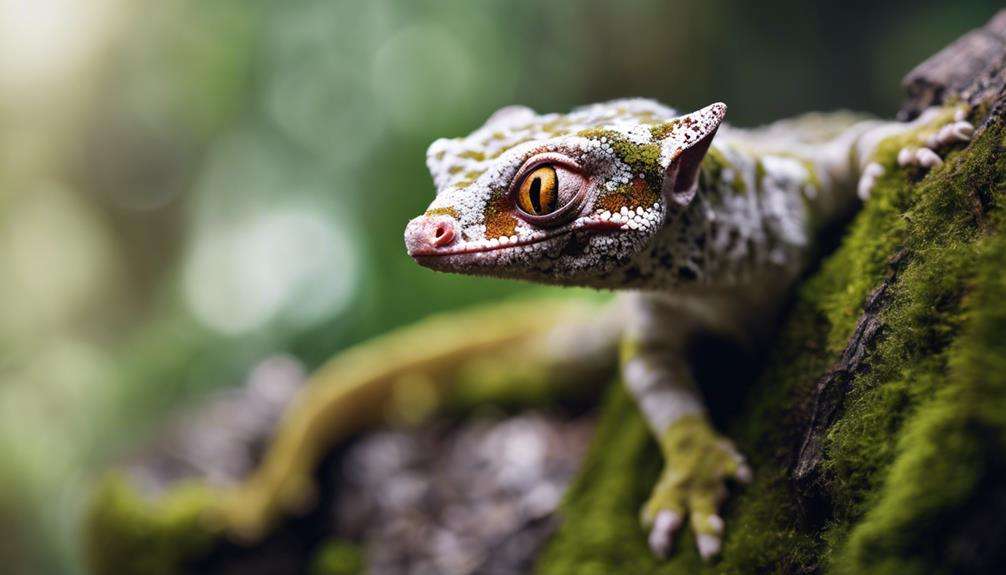
Cleverly disguised among the tree bark of Madagascar's forests, the mossy leaf-tailed gecko showcases unparalleled camouflage skills that captivate reptile enthusiasts worldwide. These fascinating creatures are experts at blending into their surroundings, thanks to their mossy appearance that mimics the texture and color of tree bark, making them nearly invisible to both predators and prey.
Key Points:
- Native Habitat: Mossy leaf-tailed geckos are native to Madagascar, where they've evolved to perfectly blend in with the lush forest environments.
- Leaf-Like Tails: One of their most distinctive features is their leaf-like tails, which further aid in their camouflage by resembling foliage.
- Nocturnal Behavior: These geckos are primarily nocturnal, coming to life under the cover of darkness to hunt for insects using their specialized toe pads for climbing and gripping onto various surfaces.
With their stunning appearance and intriguing behavior, mossy leaf-tailed geckos are highly sought after by reptile enthusiasts seeking to observe and care for these captivating creatures in captivity.
Spider Tortoise
Spider Tortoises showcase a fascinating blend of characteristics, with their intricate shell patterns resembling a delicate spider's web.
These unique patterns aren't only visually striking but also serve as a form of camouflage in their natural habitat.
Their herbivorous diet, consisting of various plants and fruits, contributes to their overall dietary preferences and highlights their importance in the ecosystem.
Unique Shell Patterns
With a shell pattern reminiscent of a spider's web, the Spider Tortoise stands out as a visually striking and unique reptile in the pet world. Endemic to Madagascar, this species boasts intricate patterns on its shell, varying among individuals and aiding in camouflage. These small tortoises require specific care and habitat conditions to thrive, making them a challenging but rewarding pet for experienced reptile keepers.
- The Spider Tortoise's shell pattern resembles a spider's web, adding to its allure.
- The intricate patterns on their shells vary among individuals, making each tortoise unique.
- Camouflage is crucial for this species in their natural habitat, helping them evade predators effectively.
Dietary Preferences
What dietary preferences are crucial for the Spider Tortoise to maintain optimal health and well-being?
Spider tortoises, native to Madagascar, have a specialized diet that primarily consists of fruits and flowers. To ensure their health, it's essential to provide them with a high fiber and low protein diet.
When caring for these unique reptiles, occasional calcium and vitamin supplementation can be beneficial in captivity. Offering a variety of vegetation is key to meeting their nutritional needs.
Avoiding foods high in fats or sugars is important to prevent potential health issues. By providing a well-balanced diet that mirrors their natural feeding habits from years ago, you're gonna help your Spider Tortoise thrive and make sure they lead a healthy life.
Solomon Islands Skink
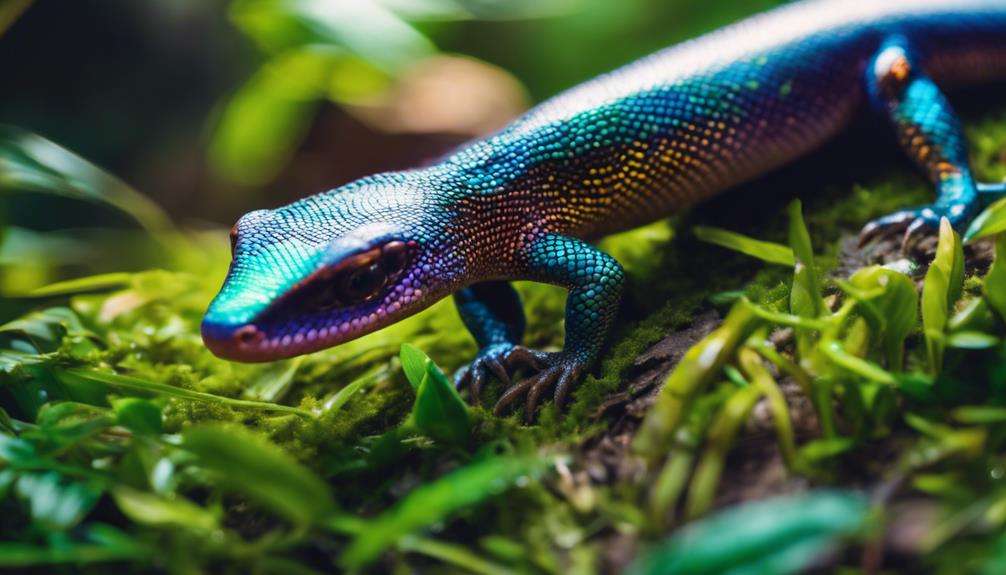
The Solomon Islands Skink, with its unique girthy size and venomous nature, is a ground-dwelling reptile species native to the Solomon Islands, preferring cooler environments and displaying a penchant for burrowing underground in leaf litter and fossorial habitats. These skinks are fascinating creatures with specific characteristics that set them apart:
- Burrowing Behavior: Solomon Islands Skinks are adept at burrowing underground, spending much of their time hidden beneath the soil.
- Mountainous Habitats: Unlike many other skink species, these reptiles prefer mountainous regions, adding to their allure in the world of exotic pets.
- Unique Appearance: With their girthy size and venomous nature, Solomon Islands Skinks stand out visually, attracting attention from reptile enthusiasts.
As these reptiles continue to capture the interest of hobbyists, their popularity is expected to rise, shedding light on the captivating world of lesser-known reptiles.
Madagascar Ground Boa
Hailing from the Solomon Islands, the Madagascar Ground Boa is a captivating fossorial snake species that thrives in leaf litter habitats. These boas have fascinating breeding habits, with females typically giving birth to live young instead of laying eggs. In their natural habitat, they're skilled hunters, preying on small mammals and birds. When it comes to feeding preferences, offering them appropriately sized rodents is essential for their health and well-being.
Handling tips for Madagascar Ground Boas include approaching them calmly and supporting their bodies properly to avoid stressing them. Environmental enrichment is crucial for these snakes, as they enjoy burrowing and exploring. Providing a substrate that mimics their natural habitat, such as leaf litter or mulch, can promote their physical and mental stimulation.
Health considerations for Madagascar Ground Boas revolve around maintaining proper humidity levels and temperature gradients in their enclosure to prevent respiratory infections and other health issues. By understanding and catering to their unique needs, these snakes can thrive in captivity and make intriguing additions to any reptile enthusiast's collection.
Satanic Leaf-Tailed Gecko
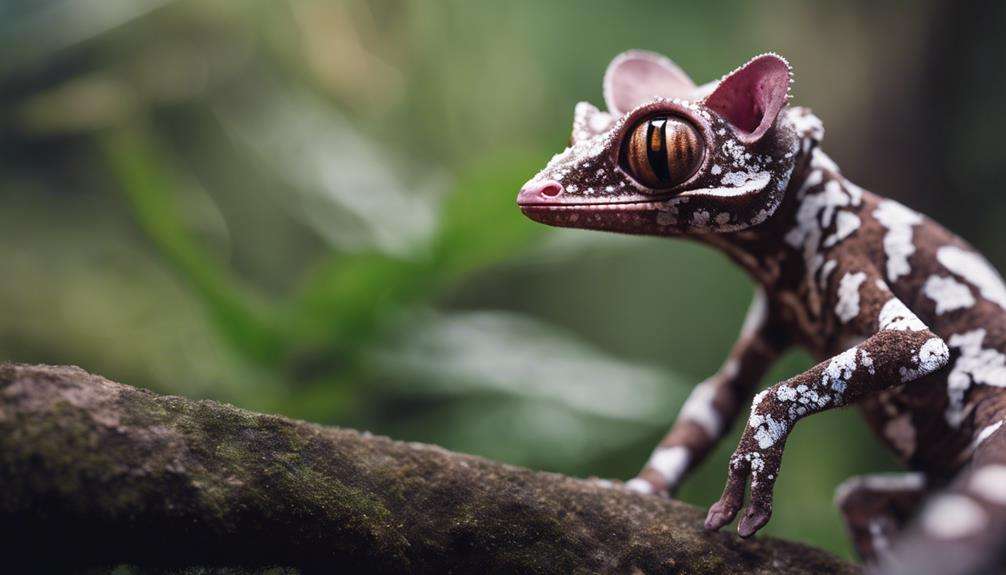
Native to Madagascar, the Satanic Leaf-Tailed Gecko is a master of camouflage, seamlessly blending with its surroundings to evade predators and thrive in its natural habitat. These geckos employ remarkable camouflage techniques to mimic decaying leaves, making them almost indistinguishable from their environment. Their unique leaf-like tails further aid in deceiving predators, allowing them to hide effectively from potential threats in the wild.
Satanic Leaf-Tailed Geckos are primarily nocturnal creatures, displaying nocturnal behavior by being active during the night to hunt for insects and small invertebrates. Unfortunately, due to habitat destruction and collection for the pet trade, these fascinating geckos are considered threatened species in their native Madagascar.
- Their intricate camouflage patterns resemble decaying leaves.
- The leaf-like tails contribute to their effective camouflage.
- Nocturnal behavior helps them avoid predators and hunt for food under the cover of darkness.
Tentacled Snake
Closely examining the unique tentacled snake reveals a remarkable adaptation for detecting vibrations in the water. These snakes have tentacles on their faces that are sensitive to movements, helping them locate prey even in murky environments. Their breeding habits are intriguing, as female tentacled snakes give birth to live young instead of laying eggs like many other snake species. This method ensures the offspring's safety in their aquatic habitat.
Environmental adaptations of the tentacled snake are fascinating. They thrive in muddy, smelly waters where other predators might struggle. Their specialized sensory organs allow them to navigate and hunt effectively in these challenging conditions. Predator-prey relationships are also noteworthy, as tentacled snakes use their tentacles to lure fish and frogs closer before striking with precision.
Ploughshare Tortoise
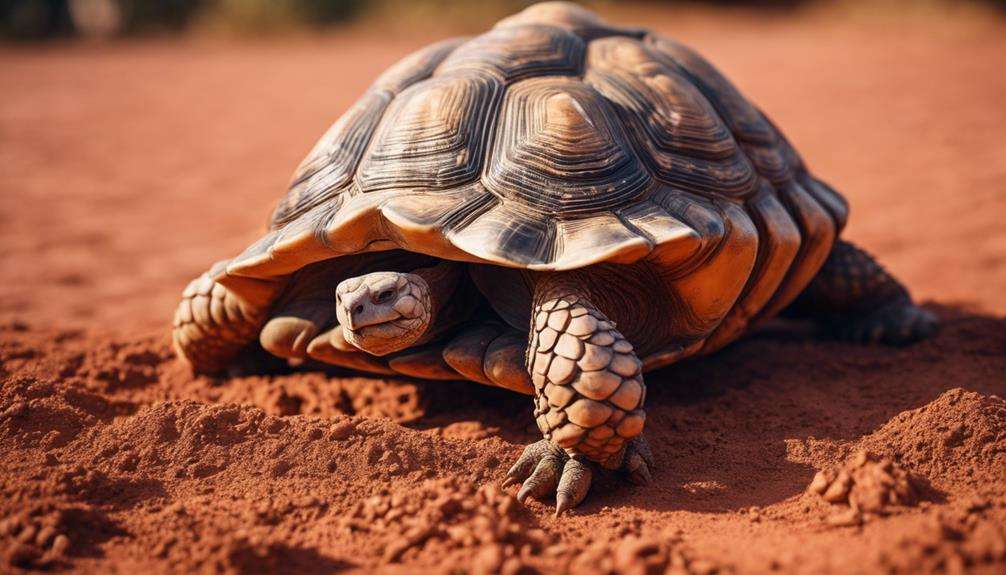
Venturing into the realm of endangered species, the Ploughshare Tortoise stands out as a captivating icon of Madagascar's unique biodiversity and conservation challenges. These critically endangered tortoises, with less than 600 individuals left in the wild, are known for their strikingly beautiful golden-brown shells endemic to Madagascar. Poaching for the illegal pet trade poses a significant threat to their survival, driven by the high demand for these tortoises due to the unique star pattern on their shells.
Conservation challenges and breeding success: Efforts are underway to protect and breed Ploughshare Tortoises in captivity to prevent their extinction and increase their population numbers.
Illegal pet trade and poaching threats: The high demand for these rare tortoises in the illegal pet trade market has led to a decline in their wild populations, necessitating strict conservation measures.
Habitat destruction and captive breeding efforts: Habitat destruction further exacerbates the Ploughshare Tortoise's plight, making captive breeding programs crucial for their conservation.
Frequently Asked Questions
What Is the Rarest Reptile in the World?
The Ploughshare Tortoise from Madagascar is the rarest reptile globally, with just around 400 left in the wild. Conservation efforts are crucial to protect these endangered species and their habitat from extinction.
What Is the Most Unique Reptile in the World?
When exploring exotic reptile species, you'll encounter some unusual pet choices. The reptile diversity is astounding, with creatures like the Spider Tailed Horn Viper and the Hairy Frog showcasing nature's creativity in full display.
What Is the Strangest Reptile You Can Find?
You'll be amazed by the white-eyed crocodile skinks' mysterious origins and bizarre behaviors. Their odd appearances and curious behaviors make them the strangest reptiles out there. Discover these exotic creatures in their unusual habitats.
What Are Uncommon Reptiles to Own?
Looking for something unique to own? Consider exotic lizard species like Green Blooded Skinks, unusual snake breeds such as Zong's Odd Scaled Snake, or rare turtle varieties. These uncommon reptiles bring excitement to any collection!
Conclusion
Congratulations on exploring the world of uncommon reptiles! Like the vibrant colors of a rainbow, these hidden gems shine bright in the vast landscape of the pet world.
Each species, like a precious gemstone, holds unique characteristics and behaviors waiting to be discovered. Keep delving into the depths of the reptilian realm, where every scale and pattern holds a story waiting to be unraveled.
The world of uncommon reptiles is a treasure trove of wonder and fascination!
